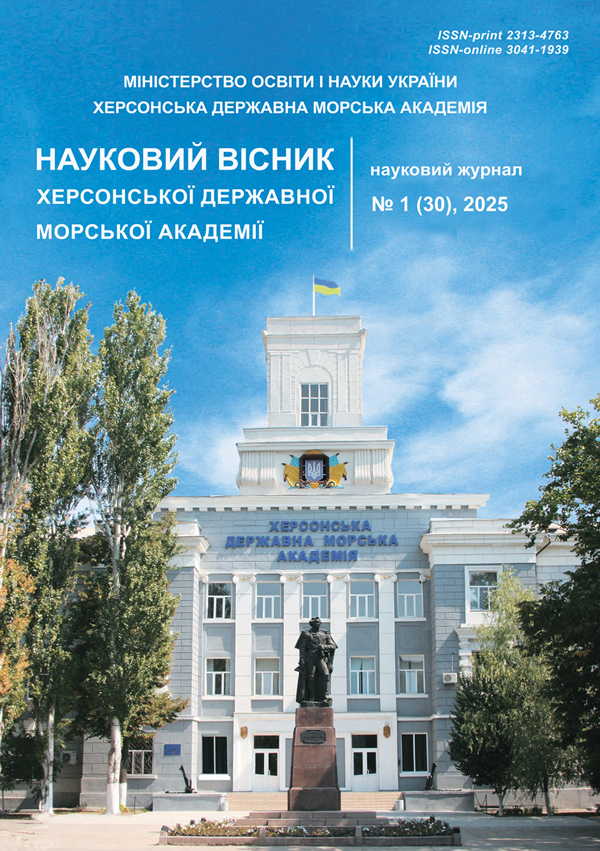INTELLIGENT INFORMATIONMEASUREMENT SYSTEM FOR DIAGNOSTICS AND MONITORING OF A HYBRID MARINE TURBOCHARGER WITH A FUZZY MODEL
https://doi.org/10.33815/2313-4763.2025.1.30.031-044
Abstract
This paper focuses on enhancing the efficiency and reliability of modern marine power units through advanced diagnostic and monitoring systems. It presents an intelligent information-measuring system (IMS) designed for real-time condition monitoring of hybrid marine turbochargers (HMTCs), which integrate exhaust gas recovery with auxiliary electric motor/generator support. Due to their complexity and demanding operational conditions, HMTCs require sophisticated diagnostics. The proposed IMS leverages fuzzy logic for adaptive control and predictive maintenance. The IMS is structured to process multi-parameter data streams from sensors that monitor not only key parameters of the turbo-gas-dynamic components (such as temperature, pressure, rotational speed, vibrations, and lubrication) but also the operational parameters of the electrical machine. Fuzzy logic algorithms enable precise sensor data interpretation, addressing real-world uncertainty and formalizing expert knowledge. The system employs fuzzification, fuzzy inference rules, and defuzzification to generate accurate diagnostic assessments, distinguishing normal operation, potential deviations, and critical faults. With growing industry demands for fuel efficiency and reliability, conventional diagnostics often fail to account for HMTC complexities. The scientific novelty of this research lies in its adaptive diagnostic process using fuzzy logic, which models expert-derived rules for nuanced fault detection. The IMS aids in optimizing control parameters, regulating supercharging, and activating emergency systems, thereby improving early fault detection. This IMS has significant maritime applications, particularly for vessels with hybrid turbocharging. By supporting condition-based maintenance, it reduces downtime and enhances operational efficiency. Its ability to ensure reliable engine performance promotes safer maritime operations and contributes to sustainable shipping through improved fuel economy. Future research could explore experimental validation and broader integration into ship energy management systems.
References
2. Adams, J., Parlikad, A. K., & Amadi-Echendu, J. (2017). A Bibliographic Review of Trends in the Application of ‘Criticality’ Towards the Management of Engineered Assets. U Lecture Notes in Mechanical Engineering (s. 11–21). https://doi.org/10.3390/en17020392.
3. Shiraishi, K, Y., Ono, Y., & Sugishita, K. (2010). Development of Large Marine Hybrid Turbocharger for Generating Electric Power with Exhaust Gas from the Main Engine. Shiraishi Mitsubishi Heavy Industries Technical Review, 47(3), 3–53.
4. Ono, Y., Shiraishi, K., & Yamashita, Y. (2012). Application of a Large Hybrid Turbocharger for Marine Electric-power Generation. Mitsubishi Heavy Industries Technical Review, 49(1), 29–33.
5. Voronenko, S. V., Subbotin, O. V., Lebedenko, Y. O., & Rudakova, H. V. (2020). Analysis of the Control System Efficiency of the Ship Integrated Electricity Installing Turbo with the Influence of External Factors. Applied Questions of Mathematical Modeling, 3(2.1). https://doi.org/10.32782/kntu2618-0340/2020.3.2-1.5.
6. TCA Project Guide. Exhaust Gas Turbocharger. (b. d.). https://engine.od.ua/ufiles/TCA-turbochargers-Project-Guide.pdf.
7. Figari, M., Theotokatos, G., Coraddu, A., Stoumpos, S., & Mondella, T. (2022). Parametric investigation and optimal selection of the hybrid turbocharger system for a large marine four-stroke dual-fuel engine. Applied Thermal Engineering, 208, 117991. https://doi.org/10.1016/j.applthermaleng.2021.117991.
8. Gharib, H., & Kovács, G. (2024). Implementation and Possibilities of Fuzzy Logic for Optimal Operation and Maintenance of Marine Diesel Engines. Machines, 12(6). https://doi.org/10.3390/machines12060425.
9. Voronenko, S., & Korolenko, E. (2015). Intehruvalnyi pidkhid do diahnostyky sudnovykh turboheneratoriv. U IV osinni naukovi chytannia: zbirnyk naukovykh publikatsii «Veles» za materialamy mizhnar. nauk.-prakt. konf. m. Kyiv, 12 zhovt. 2015 r (s. 55–56).
10. Castro, P. F., Lira, G. R. S. d., Vilar, P. B., Costa, E. G. d., & Carvalho, F. B. S. (2024b). Fuzzy Inference System Development for Turbogenerator Failure Diagnosis on Floating Production Offloading and Storage Platform. Energies, 17(2), 392. https://doi.org/10.3390/en17020392.
11. Wijetunge, R. S., Brace, C. J., Hawley, J. G., & Vaughan, N. D. (2000). Fuzzy logic control of diesel engine turbocharging and exhaust gas recirculation. Food Chemistry. P. 11–21.
12. Polyvoda, O., Rudakova, H., Kondratieva, I., Rozov, Y., & Lebedenko, Y. (2019). Digital Acoustic Signal Processing Methods for Diagnosing Electromechanical Systems. U Advances in Intelligent Systems and Computing (s. 97–109). Springer International Publishing. https://doi.org/10.1007/978-3-030-26474-1_7.
13. Varbanets, R. A., Klymenko, V. H., Minchev, D. S., Zalozh, V. I., Kyrnats, V. I., & Aleksandrovska, N. I. (2020). Diahnostyka turbokompresora dyzelnoho dvyhuna za dopomohoiu analizu vibroakustychnoho spektru. Aerospace technic and technology, (6), 24–33. https://doi.org/10.32620/aktt.2020.6.03.
14. ISO 20816-8:2018 Mechanical vibration – Measurement and evaluation of machine vibrationPart 8: Reciprocating compressor systems URL: https://www.iso.org/standard/75440.html (дата звернення: 25.05.2025).
15. Zadeh, L. A. (1965). Fuzzy sets. Information and Control, 8(3), 338–353. https://doi.org/10.1016/s0019-9958(65)90241-x.
16. Mamdani, E. H. (1974). Application of fuzzy algorithms for control of simple dynamic plant. Proceedings of the Institution of Electrical Engineers, 121(12), 1585. https://doi.org/10.1049/piee.1974.0328.
17. Takagi, T., & Sugeno, M. (1985). Fuzzy identification of systems and its applications to modeling and control. IEEE Transactions on Systems, Man, and Cybernetics, SMC-15(1), 116–132. https://doi.org/10.1109/tsmc.1985.6313399.






